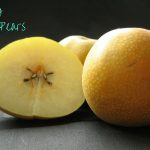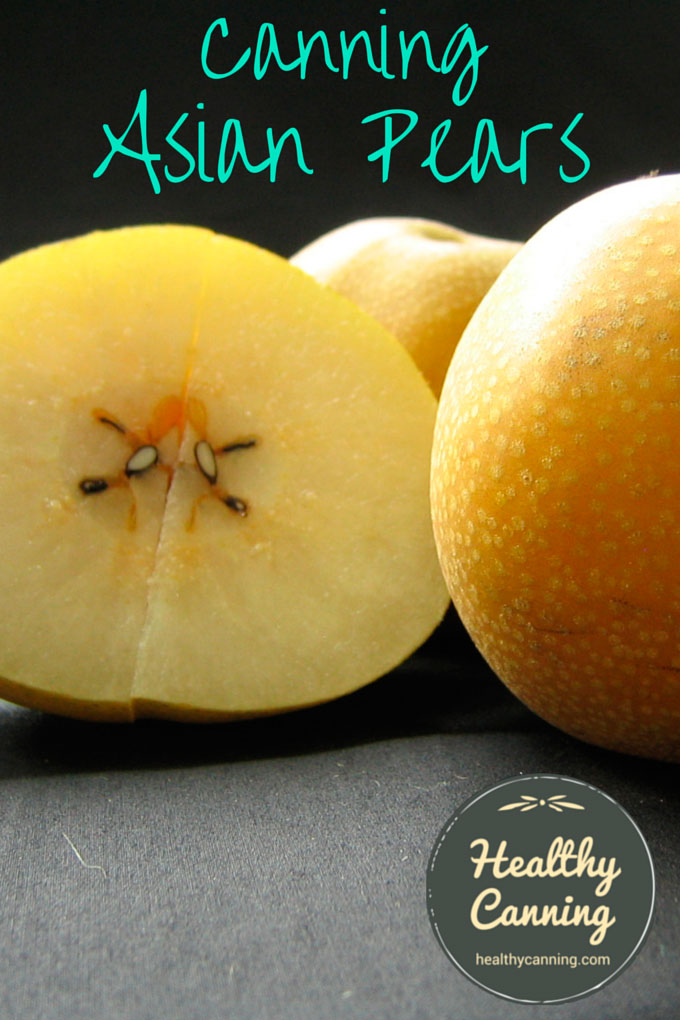Asian Pears are indeed true pears, just like their European cousins, but they do have a few different characteristics. They stay crisp. They will ripen beautifully while still on the tree. And, their acidity level is far lower than European pears. That means, for canning purposes, Asian pears must be handled a bit differently from European pears.
Oregon State Extension says,
Asian pears, apple pears, and Oriental pears (which are actually a different tree fruit crop) must be acidified before canning.” [1] Oregon State University Extension Service. Preserving Foods: Pears. SP 50-678. Revised February 2014. Accessed March 2015.
The recipe
Hot Pack Directions
Jars: Half-litre (1 US pint / 500 ml/ 16 oz) OR litre (1 quart / 32 oz) jars.
Processing method: Either water-bath or steam canning
Yield: varies
Headspace: 2 cm (½ inch)
Processing time: Half-litre (pint) 20 minutes; litre (quart) 25 minutes.

Canning Asian pears - hot pack
Ingredients
- Asian pears
- water
- lemon juice (bottled)
Instructions
- Wash and peel the pears. Slice the pears in half, and core them. Cut into slices if desired, or leave as halves. Put pieces into water with some lemon juice (or ascorbic acid) in it as you are working so they won't brown on you.
- Drain pear pieces and discard soaking water, put in a large pot of boiling water, bring water back to the boil and boil for 5 minutes.
- Pack fruit loosely into hot jars, leaving 3 cm (1 inch) headspace.
- To each half-litre (US pint) jar, add 1 tablespoon lemon juice; OR To each litre (US quart) jar, add 2 tablespoons lemon juice.
- Fill jars with the blanching water, leaving 2 cm (½ inch) headspace.
- Debubble, adjust headspace.
- Wipe jar rims.
- Put lids on.
- Process in a water bath or steam canner.
- Process half-litre (US pint) jars for 20 minutes; litre (US quart) jars for 25 minutes.
- Increase time as needed for your altitude.
Notes
Nutrition
| Required processing time in minutes per altitude | ||||
|---|---|---|---|---|
| Jar Size | 0 - 305 m / 0 - 1,000 ft | 306 - 915 m / 1,001 - 3,000 ft | 916 - 1,830 m / 3,001 - 6,000 ft | Above 1,831 m / 6,000 |
| ½ litre (US pint) | 20 min | 25 | 30 | 35 |
| 1 litre (US quart) | 25 | 30 | 35 | 40 |
When water-bath canning or steam canning, you must adjust the processing time for your altitude.
The canning liquid
Above, we have give directions for canning in plain water. However, you do have other choices as well. The USDA says: “Prepare a very light, light, or medium syrup or pack pears in apple juice, white grape juice, or water.”
You could also can in water, and per half-litre / pint, add a teaspoon of liquid stevia, doubling that for the litre / quart jars.
To be clear, adding the bottled lemon juice to whatever liquid you choose is not optional.
Raw Pack Directions
Processing method: Water bath or steam canning
The USDA lists only hot pack directions. This may be because most authorities seem to say that end-result quality suffers with raw-packed pears (a common complaint seems to be that raw-packed pears discolour.)
Directions for raw-packing Asian pears can, however, be found at Oregon State University Extension Service, where the canning procedure for these pears was invented: Preserving Foods: Asian Pears. [2]Preserving Foods: Asian Pears. Oregon State University Extension Service. SP 50-694, Reprinted February 2013.
Note however that raw packs for any fruit are not recommended for sugar-free canning, owing to quality issues.
How to make Asian Pears safe for canning
It doesn’t take much effort at all to make Asian Pears safe for home canning. Basically just add a splodge of bottled lemon juice to the canning liquid:
- Per half-litre (1 US pint) jar add 1 tablespoon of bottled lemon juice or ¼ teaspoon citric acid;
- Per litre (1 US quart) jar add 2 tablespoons of bottled lemon juice or ½ teaspoon citric acid.
You do need to use bottled lemon juice to be 110% sure of the acidity level of the lemon juice. It’s there for safety, not taste.
(Note: Oregon State says that instead of lemon juice, you can use citric acid in the quantities mentioned above. But, they also say, “Citric acid … is less desirable because of its strong flavor.” [3]Oregon State University Extension Service. Critical Canning Steps. Products Requiring Acidification: Figs and Asian pears. SP 50-749. Revised March 2013. Accessed May 2015. ) This does seem to contradict many other home canning authorities who, in other contexts, say that they feel citric acid has little if any discernible taste.
As for the canning liquid, you may can the pear in a juice such as apple or white grape, in plain water, or in sweetened water. Healthycanning.com uses plain water with liquid stevia to sweeten it. It’s a more neutral taste than juice, and juices can get pricey fast as canning liquids. On the other hand, canning them in completely unsweetened plain water gives you maximum usage flexibility when you open the jars.
Recipe source
Pears, Asian. In: United States Department of Agriculture (USDA). Complete guide to home canning. Agriculture information bulletin No. 539. 2015. Page 2-20.
History of home-canning Asian Pears
In 2009, the USDA Complete Guide added the process for Asian Pears, based on research done at Oregon State (by Woodburn, Raab, Hilderbrand) where researchers developed water bath processes for the acidified pears. [4] Andress, Elizabeth. “History, Science and Current Practice in Home Food Preservation.” Webinar. 27 February 2013. Accessed January 2015. What the USDA didn’t bring over, though, it seems, was the raw pack part of the findings. Either they chose not to for food quality reasons, or, it may have been developed after 2009.
References

